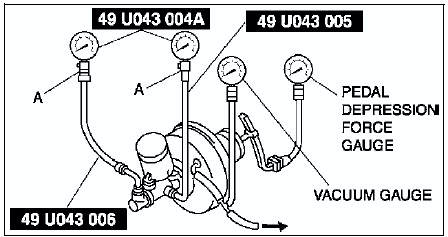Mazda 6 Service Manual: Power brake unit inspection
Warning
- The following inspection methods are the simple inspection methods to judge the function of power brake.
- If there is malfunction in power brake unit, replace the power brake unit as a component.
Power Brake Unit Function Check (Simple Method)
Step 1
1. With the engine stopped, depress the pedal a few times.
2. With the pedal depressed, start the engine.
3. If the pedal moves down slightly immediately after the engine starts, the unit is operating.
Step 2
1. Start the engine.
2. Stop the engine after it has run for 1 or 2 minutes.
3. Depress the pedal with the usual force.
4. If the first pedal stroke is long and becomes shorter with subsequent strokes, the unit is operating.
- If a problem is found, inspect for damage of the vacuum hose, and vacuum tank. Repair if necessary, and inspect it again.
Step 3
1. Start the engine.
2. Depress the pedal with usual force.
3. If the pedal height does not change, the unit is operating.
4. Hold the pedal down for about 30 seconds.
5. If the pedal height does not change, the unit is operating.
Power Brake Unit Function Check (Inspection Using The Testers)
Connect the SSTs
, vacuum gauge, and pedal depression force gauge as shown in the figure to bleed the air from SSTs
and brake line. (Bleed the air from SSTs
using a air bleed valve A.)

Checking for vacuum loss (unloaded condition)
1. Stop the engine when the vacuum gauge reading reaches 66.7 kPa {500 mmHg, 19.7 inHg}.
2. Observe the vacuum gauge for 15 seconds.
- If the gauge shows 63.3-66.7 kPa {475-500 mmHg, 18.7-19.6 inHg}
, the unit is operating.
- If not, inspect for damage on the check valve or vacuum hose, and examine the installation. Repair as necessary, and inspect it again.
Checking for vacuum loss (loaded condition)
1. Start the engine.
2. Depress the brake pedal with a force of 196 N {20 kgf, 44 lbf}.
3. Stop the engine when the vacuum gauge reading reaches 66.7 kPa {500 mmHg, 19.7 inHg}.
4. Observe the vacuum gauge for 15 seconds.
5. If the gauge shows 63.3-66.7 kPa {475-500 mmHg, 18.7-19.6 inHg},
the unit is operating.
Checking for hydraulic pressure
1. When the engine is stopped (vacuum 0 kPa {0 mmHg, 0 inHg}
) and the fluid pressure is within the specification, the unit is operating.

2. Start the engine. Depress the brake pedal when the vacuum reaches 66.7 kPa {500 mmHg, 19.7 inHg}.
- If the fluid pressure is within the specification, the unit is operating.
- If the fluid pressure is not as specified, inspect for damage to the check valve or vacuum hose, and fluid leakage of the hydraulic line. Repair as necessary, and inspect again.

 Power brake unit removal/installation
Power brake unit removal/installation
1. Remove the master cylinder. (See MASTER CYLINDER REMOVAL/INSTALLATION.)
2. Remove the wiper arm. (See WINDSHIELD WIPER ARM AND BLADE
REMOVAL/INSTALLATION.)
3. Remove the cowl grille. (See COWL ...
 Dual proportioning valve inspection (without abs)
Dual proportioning valve inspection (without abs)
1. Connect the SSTs to the brake pipes as shown in the figure.
2. Bleed the air from the brake system.
3. Measure the fluid pressure of the master cylinder and the rear brake.
If not within th ...
Other materials:
Mazda 6 Service Manual: Vinyl Upholstery Maintenance
Remove dust and dirt from the vinyl upholstery using a brush or vacuum. Remove
soiling from vinyl upholstery using a leather and vinyl upholstery cleaner.
Upholstery Maintenance
1. Clean the soiled area by lightly dabbing it with a soft cloth soaked in a
mild detergent (approx. 5%) diluted wit ...
Mazda 6 Service Manual: Starter removal/installation
Warning
When the battery cables are connected, touching the vehicle body with starter
terminal B will generate sparks. This can cause personal injury, fire, and
damage to the electrical components. Always disconnect the battery negative
cables before performing the following operation.
1. Di ...
